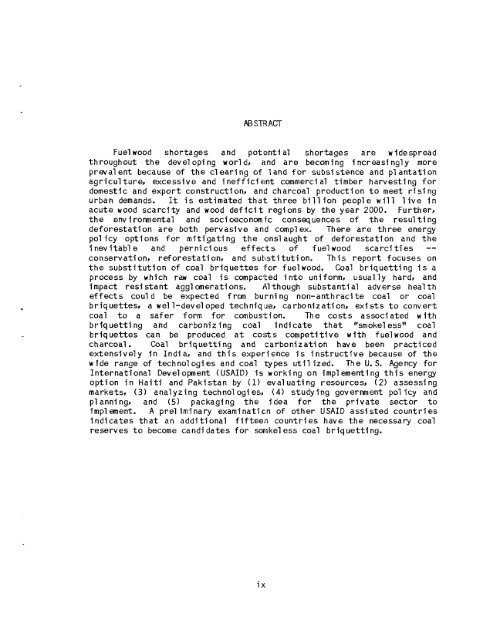Prospects for Coal Briquettes as a Substitute Fuel for Wood and ...
Prospects for Coal Briquettes as a Substitute Fuel for Wood and ...
Prospects for Coal Briquettes as a Substitute Fuel for Wood and ...
Create successful ePaper yourself
Turn your PDF publications into a flip-book with our unique Google optimized e-Paper software.
AB STR ACT<br />
<strong>Fuel</strong> wood shortages <strong>and</strong> potonti a1 shortages are widespread<br />
throughout the devel oping world, <strong>and</strong> are becoming incre<strong>as</strong>ingly more<br />
prwal ent because of the cl e<strong>as</strong>i ng of 1 <strong>and</strong> <strong>for</strong> subsi stence <strong>and</strong> pl antati on<br />
agriculture, excessive <strong>and</strong> ineffici snt commerci a1 timber harvesting <strong>for</strong><br />
domestic <strong>and</strong> export construction, <strong>and</strong> charcoal production to meet risi ng<br />
urban dem<strong>and</strong>s. It is estimated that three billion people w i l l live in<br />
acute wood scarcity <strong>and</strong> wood deficit regions by the year 20QQ. Further,<br />
the env iromental <strong>and</strong> socioeconomic consequences of the resulting<br />
de<strong>for</strong>estatdon are both perv<strong>as</strong>ive <strong>and</strong> complex. There are three energy<br />
policy options <strong>for</strong> mitigating the onslaught of de<strong>for</strong>estatjon <strong>and</strong> the<br />
1 nev itabl e <strong>and</strong> perni ci ous effects of fuel wood scarcities --<br />
conservation, re<strong>for</strong>estation, <strong>and</strong> substitution. This report focuses on<br />
the substitution of coal briquettes <strong>for</strong> fuelwood. <strong>Coal</strong> briquetting is a<br />
process by which raw coal is compacted into uni<strong>for</strong>m, usually hardr <strong>and</strong><br />
impact res4 stant aggl omerations. A1 though substantial adverse heal th<br />
effects could be expected from burning non-anthracite coal or coal<br />
briquettes, a we1 1-devel oped technique, carbonization, exists to convert<br />
coal to a safer <strong>for</strong>m <strong>for</strong> combustion. The costs <strong>as</strong>sociated with<br />
brfquetting <strong>and</strong> carbonizing coal indicate that 8fsmokel esstV coal<br />
briquettes can be produced at costs competitive with fuel wood <strong>and</strong><br />
charcoal. <strong>Coal</strong> briquetting <strong>and</strong> carbonization have bean practiced<br />
extensively in India, <strong>and</strong> this experience is instructjve because of the<br />
wlde range of technologies <strong>and</strong> coal types uti1 ized. The U. S. Agency <strong>for</strong><br />
International Development (USAID) is working on imp1 emanling this energy<br />
option in Haiti <strong>and</strong> Pakistan by (1) evaluating resources, (2) <strong>as</strong>sessing<br />
markets, (3) analyzing techno7 ogi esr (4) studying government pol icy <strong>and</strong><br />
plannings <strong>and</strong> (5) packaging the idea <strong>for</strong> the private sector to<br />
implement. A prel iminary exarninatjcn of other USAID <strong>as</strong>sisted countries<br />
Indicates that an additional fifteeii countries have the necessary coal<br />
reserves to become c<strong>and</strong>idates <strong>for</strong> sonikel ess coal briq uetti ng.<br />
ix

















